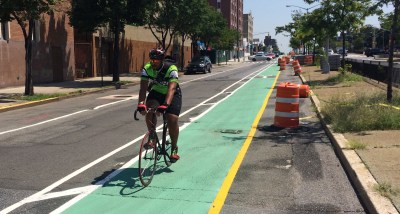Big Turnout for DOT’s First Queens Boulevard Safety Workshop

Change is coming to the most feared street in New York.
More than 100 people turned out last night to tell NYC DOT how they want to improve safety on Queens Boulevard. Known as the Boulevard of Death for its appalling record of traffic fatalities and injuries, Queens Boulevard functions as a surface-level highway running through more than seven miles of densely settled neighborhoods. DOT Commissioner Polly Trottenberg announced last week that it would be a Vision Zero priority in 2015, and Wednesday’s meeting kicked off what advocates hope will be a comprehensive yet expeditious process to redesign the street for safe walking and biking and effective transit.
Queens Boulevard remains one of the deadliest streets in the city, even after signal timing changes and other adjustments led to major reductions in pedestrian deaths about 15 years ago. In 2013 alone, six pedestrians were killed on the street, reports the Times Ledger.
Streetsblog couldn’t attend last night, so we reached out to Queens residents this morning to get their take on the event. There’s a lot of excitement for what DOT has set in motion, as well as a sense that the agency has to act swiftly and decisively to keep the momentum going.
Last night’s workshop focused on the segment of Queens Boulevard in Woodside, from Roosevelt Avenue to 73rd Street. Grouped together at 12 tables, participants were briefed by DOT staff on the agency’s street design toolkit and then each group got to work imagining how those safety improvements could apply to this stretch of Queens Boulevard. At a separate event on the Upper West Side last night, Trottenberg said those ideas will inform short-term fixes for now, with more workshops to follow for other sections, the idea being to piece together a permanent safety overhaul for the whole corridor.
Our contacts remarked on how the different perspectives at the workshop converged around similar ideas. “There was a cross-section of users of the street at the workshop, including people who walk, bike, drive, and take buses, and all who spoke mentioned feeling unsafe on the Boulevard as it is currently designed,” said Transportation Alternatives volunteer Rachel Beadle. “Participants at EVERY break-out table were asking for bike lanes, bus lanes, and safer pedestrian crossings.”
The appeal of a safer Queens Boulevard cuts across generations. Cristina Furlong of Make Queens Safer said one man at her table had lived in the neighborhood for 60 years and had been struck by a driver while riding his bike on Queens Boulevard. Another participant at her table had a 12-year-old son who’d also been struck while biking.
Council Member Jimmy van Bramer, who represents a district that touches all of Queens Boulevard west of 73rd Street, called the workshop “a testament to the will of the people who have fought long and hard to make Queens Boulevard safer,” noting that “more work needs to be done.”

DOT intends to implement the short-term ideas from last night’s workshop — things like pedestrian island extensions — this year and hold a series of workshops along other sections of Queens Boulevard stretching into 2016. A plan for the full corridor would emerge from those workshops.
Queens Boulevard is a long, complex street, making a comprehensive redesign especially challenging. “Under the train trestles and overpasses the lanes are drastically reduced, but in between the road balloons out to crazy proportions,” said Jessame Hannus. “And the road design takes a million inconsistent approaches to each of these changes.”
To achieve a safe, cohesive design along the whole length of the street, Hannus and other advocates with Transportation Alternatives and Families For Safe Streets want to see DOT rapidly expand the planning process to other neighborhoods.
“The people living along Queens Boulevard have been calling for these changes for decades,” said TA volunteer Peter Beadle. “It is great that the city and DOT have now committed to redesigning the Boulevard, but that commitment must be acted on right away.”
In a statement, Families For Safe Streets laid out a vision for Queens Boulevard as a signature Vision Zero project for New York and elsewhere:
We urge New York City to take a bold step toward realizing Vision Zero: transform the full length of Queens Boulevard into a state-of-the-art Complete Street. A Complete Street — a concept supported by urban planners, public health practitioners, and transportation advocates worldwide — is a comprehensive system that allows for safe usage by all travelers including those walking, bicycling, driving automobiles, or riding public transportation. In every instance where they have been built, Complete Streets are proven to result in a drastic reduction in fatalities and injuries from crashes for all street users. A comprehensive redesign of Queens Boulevard would require a re-imagination of the street and draw upon best practices such as shortened pedestrian crossings, protected bike lanes, dedicated lanes for buses, narrowed driving lanes, and signal changes.
We are not talking about a patchwork intersection by intersection approach. We encourage the Mayor and the DOT to make Queens Boulevard an example for what is possible and undertake a comprehensive street redesign that can be used as a model for all other NYC arterial redesign projects. Be bold. Set an example for NYC, the nation and the world that the epidemic of traffic violence on our streets is unacceptable. Create a model space drawing from proven approaches that enables safe, convenient and comfortable travel for users of all ages and abilities regardless of their mode of transportation.
Stephen Miller contributed reporting for this post.
